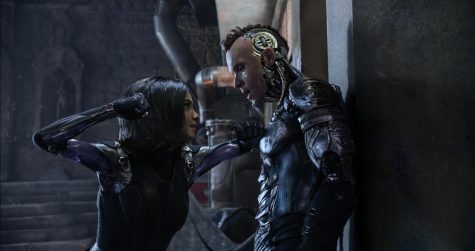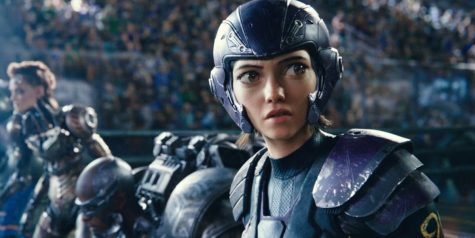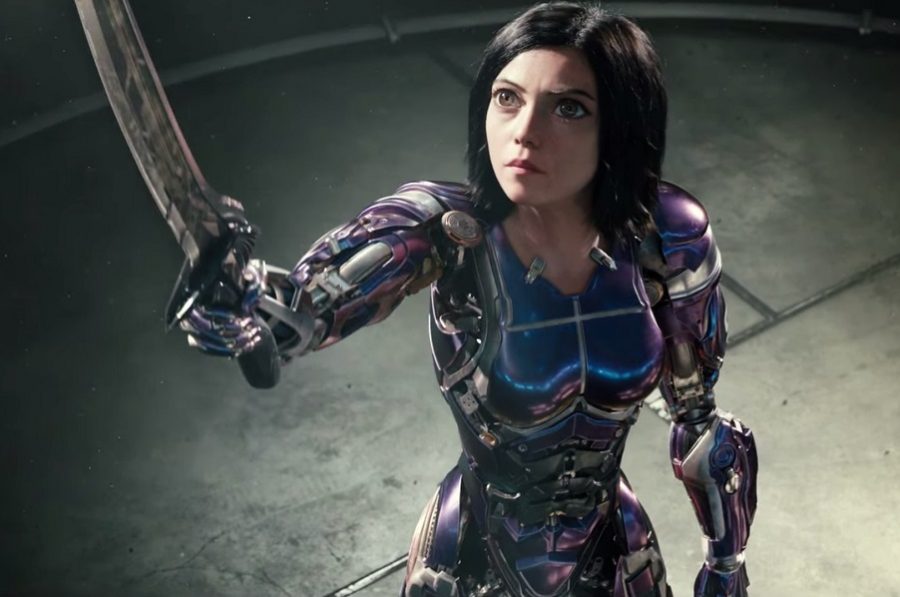“Alita: Battle Angel” delivers breathtaking cyberpunk spectacle
After a decade-long hiatus, “Avatar” creator James Cameron returns to the Hollywood scene with the visually stunning “Alita: Battle Angel.”
Rosa Salazar plays the titular character Alita in “Alita: Battle Angel”
When one considers the great directors of Hollywood who revolutionized the world of filmmaking, James Cameron is a name that will be more than likely to pop up in a high position on the list. For the past couple decades he has tinkered with a wide margin of films, from “Terminator” to “Titanic” and, most recently, to the game-changing epic “Avatar.” Yet, ever since “Avatar” came out 10 years ago, he has gone off the grid, save for a couple documentary cameo appearances. Now, joined by veteran director Robert Rodriguez (“Sin City”), Cameron marks his return to the big budget science-fiction genre with cyberpunk extravaganza “Alita: Battle Angel.”
“Battle Angel” is derived from the 1990s Japanese manga “Gunnm” created by Yukito Kishiro. As a forenote, I’m not well-versed with the original series, so I cannot judge the film in relation to its original counterpart. But on its own merits, “Battle Angel” is a grandiose spectacle that not only brings visual effects work to jaw dropping new heights, but also introduces us to a bright new heroine.
The film kicks off in the year 2563, when Earth is a technologically-advanced world. In the metropolis of Iron City, scientist Dyson Ido (Christoph Waltz) discovers the disembodied head of a young woman cyborg with a functioning brain. Ido remanufactures the cyborg and names her Alita (Rosa Salazar). As Alita immerses herself in the city landscape and tries to piece her mind together, she discovers forces from all sides that will stop at nothing with their diabolical schemes.
As a character, Alita is everything I would want from a protagonist in such a film. Her experience in the film starts from the very beginning, as she is a stranger to an otherworldly land and intent on following a trail of rediscovery. We see lots of warmth from her personality, and instantly she becomes a simultaneously lovable and relatable component to follow. In the ensuing sections of the film, there’s an expansive amount of development as many other pieces of her persona are explored. I especially savored how courageous she was. In one scene she fights off a gargantuan cyborg and, despite getting her entire lower torso and an arm sliced off, continues brawling like nothing happened. That’s true bravery right there.

Alita fights Zapan (Ed Skrein), a bounty hunter.
The most integral part of breathing life into Alita is not the character crafting, however: it’s the performance. Mercifully, Rosa Salazar gives a stellar performance as Alita. Her line delivery feels completely genuine, without an ounce of phoning it in. Salazar utterly convinces you of Alita’s emotiveness. In the hands of a less talented actress, the role could’ve been shrugged off as being forgettable, but Salazar’s noticeable dedication to bringing her to life does not allow for that.
The other performances are varied. Christoph Waltz does a fine job playing Ido as an earnest, overprotective surrogate protector to Alita. Like Salazar, he pours true dedication and emotion into the role. Jackie Earle Haley plays a hulking and at times certifiably terrifying cyborg who is sent in a hunt against Alita. On the other side of the spectrum, Keean Johnson, a newcomer actor, falls flat as Hugo, Alita’s romance interest. Mahershala Ali (coming off of “Spider-Man: Into the Spider-Verse”) is disappointingly bland as Vector, a cartoonishly villainous gambling entrepreneur.
As with “Avatar,” the visual effects excel in multiple arenas. These are the landscape, the use of motion capture to generate the characters and enticing action sequences.
Whether the film was playing out in the daytime or the nighttime, I was awed by how beautiful the landscape looked. This could have more to do with the cinematography or set design, but the visual effects definitely have a role to play nonetheless. In the daytime, it is plotted with cascades of a variety of buildings and ebullient wonders. Rodriguez and Cameron’s attention to detail is exceptional; there are many blink-and-miss types of entities spread throughout. During the nightime, the surroundings look like they came straight out of “Blade Runner,” what with a neon tint and even more of a cyberpunk feel to it than in the scenes set during the day.
The motion capture effects, attributed to Weta Digital, are superb. Like Thanos from “Infinity War” or Caesar from the rebooted “Planet of the Apes” trilogy, all of the CGI characters look eerily realistic and not like something that was cooked up on a computer by hundreds of artists. This allows you to immerse yourself completely and not get taken aback by their special effects.

Motorball in “Battle Angel”
Where the visual effects shine the most is in the action. Many similar types of action movies, especially superhero movies, have notably faltered because of their action feeling too excessively bombastic and pompous. In “Battle Angel,” they are directed fluidly by Rodriguez and are breathtakingly done. One such sequence takes place around 3/4ths of the way into the film, where Alita competes in a Motorball tournament. The fictionalized sport is more or less a fast-paced, larger scoped blend of roller skating and car racing. Needless to say, this sequence was breathtaking. It takes Alita outside of the arena as she swerves and careens into her competitors over the city, and I was in awe from the beginning to the end.
“Battle Angel” falters in several respects. First off, the romance subplot. It unfolds rather quickly, and much like other flawed romances in films and novels, comes off as undercooked and pointless. Also, I wasn’t very fond of the world building. It is understandable that the filmmakers wanted to keep the story going instead of plunging it with excessive past details, but sometimes some key background details felt like they were hastily added in. Lastly, the ending is a massive cliffhanger to set up future sequels. Considering a sequel hasn’t been confirmed as of yet, I thought this was imprudent. There should have been more focus on finishing off all of the lingering plotlines instead of leaving loose ends to be tied up in the next film.
In summation, “Alita: Battle Angel” is well worth a watch, especially if you are looking for a film with a strong heroine and remarkable cyberpunk visuals. There were a couple of nagging problems that I had, but ultimately I was exceedingly impressed with the film and would gladly watch any sequels that may be made. Be sure to watch “Battle Angel” on the largest screen possible, lest you risk not getting the full effect of the spectacle. Grade: A-
Your donation will support the student journalists of West High School. Your contribution will allow us to purchase Scholarship Yearbooks, newsroom equipment and cover our annual website hosting costs.

Edward Keen is a senior and this is his second year on staff, where he is Arts Editor. In his free time, he enjoys reading.




